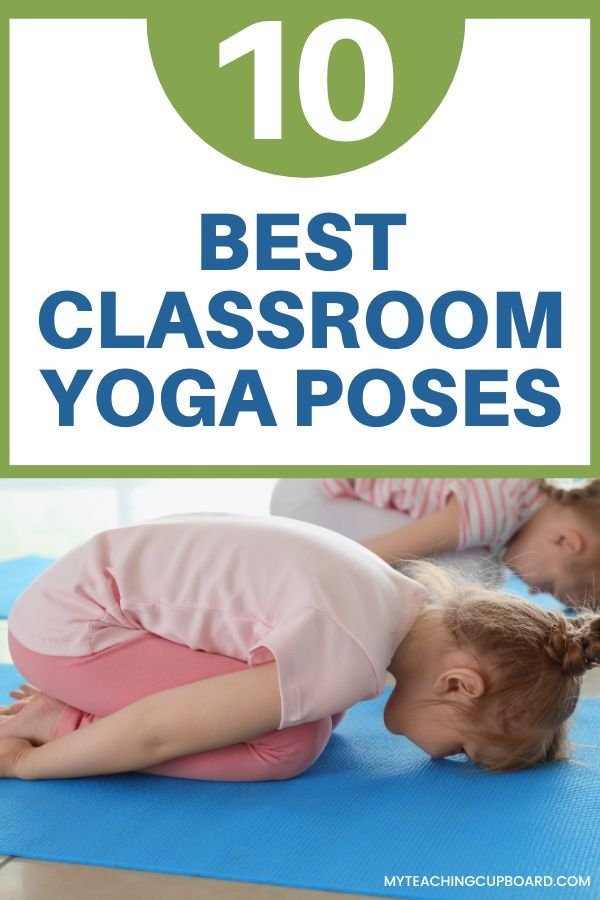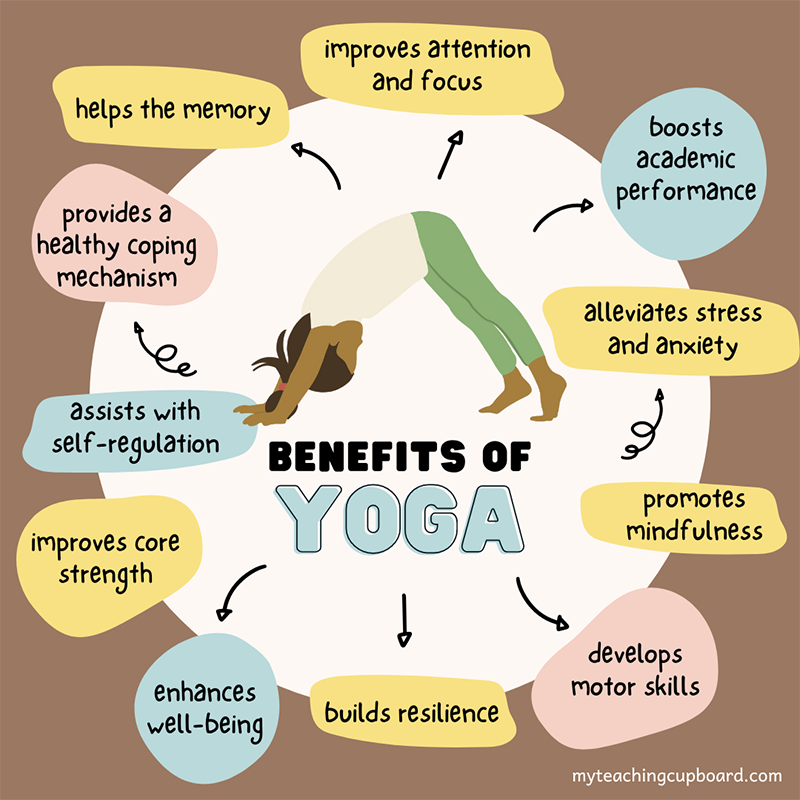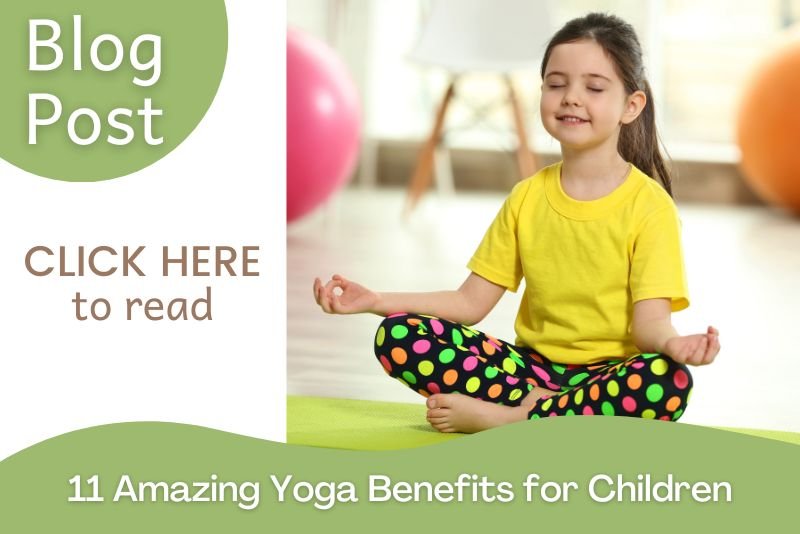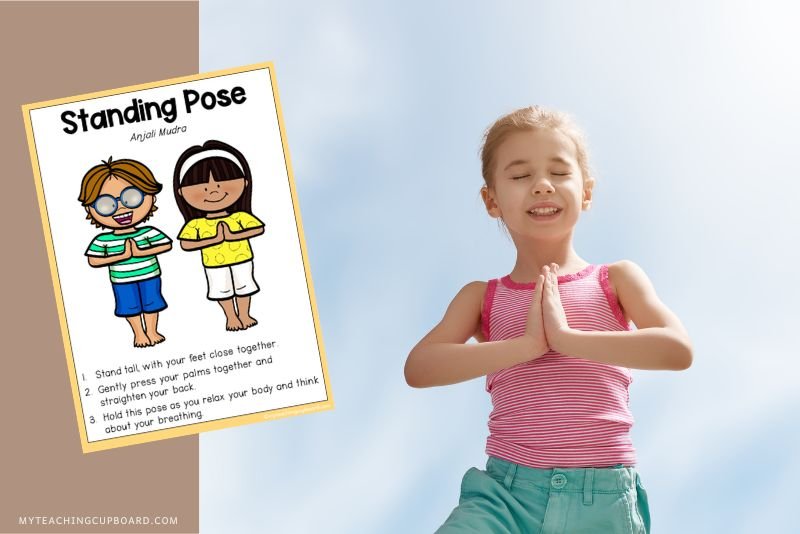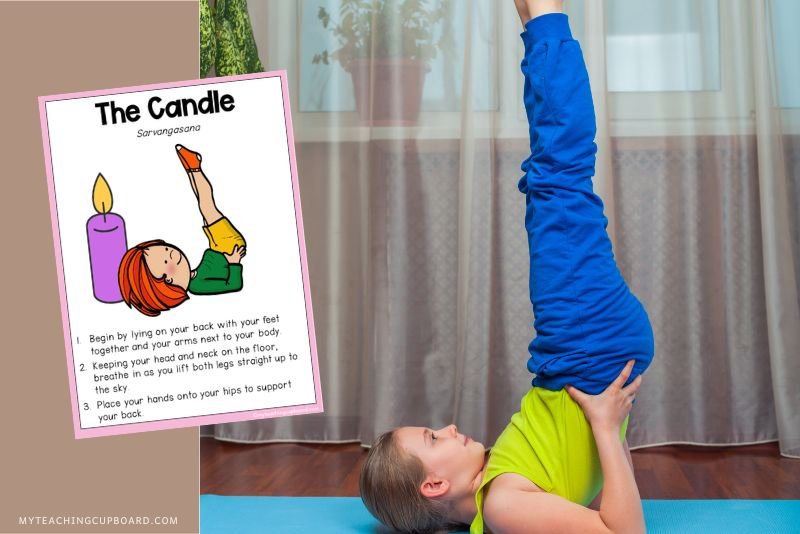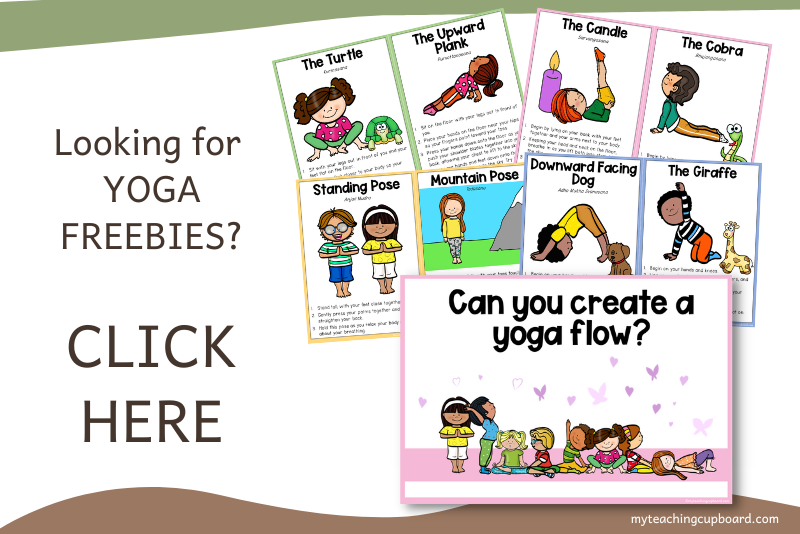10 Classroom Yoga Poses to Help Students Focus and Relax
Want to create a more peaceful and focused classroom environment? Classroom yoga is easy and effective. In this blog post, you will discover 10 easy-to-implement classroom yoga poses perfect for young children. Poses like Mountain Pose and Child's Pose will help your students focus and relax.
Managing a classroom full of energetic little ones is both rewarding and challenging. I mean, you know you're a kindergarten teacher when you consider a 5-minute break a luxury vacation!
If you are like me, you are always on the lookout for effective strategies that will help students calm down and focus. In my search for effective strategies, classroom yoga was a powerful tool that couldn’t be overlooked.
Classroom yoga benefits learning and encourages relaxation.
It is one of my favourite classroom relaxation activities. Not only does it serve as a beautiful behaviour management tool, but it's also a practice that children can take with them out into the real world too.
Yoga is an age-old practice that's perfect for little bodies and minds.
Amazing Benefits of Yoga for Students
Teaching yoga in the early years classroom has heaps of benefits for both students and teachers. It not only helps improve focus, concentration, and self-regulation skills, but it also can reduce stress and anxiety.
As well as all of that, incorporating yoga into your classroom routine can create a more positive and peaceful learning environment. The good news is that this all leads to improved academic performance and overall student well-being.
Students who practice yoga often show:
Improved Focus: Yoga requires attention to posture and breath. It promotes mindfulness practices because it helps children focus more on the present moment and the task at hand.
Better Self-Regulation: Yoga encourages self-awareness and helps kids calm their minds and bodies. Yoga improves mental health. Children who practice yoga seem to manage their emotions better.
Physical Health: Beyond the mind, yoga also offers a range of physical health benefits, from increased flexibility to improved inner core and muscle strength.
If you are wondering if you should be practising yoga in your classroom and how classroom yoga can be of benefit to the children in your class, you should check out my blog post: 11 Amazing Yoga Benefits for Children
This blog post explains in detail how kid’s yoga can:
improve attention and focus
help the memory
boost academic performance
alleviate stress and anxiety
build resilience
provide a healthy coping mechanism
improve core strength
develop motor skills
assist with self-regulation
promote mindfulness
enhance well-being
What You Need to Get Started with Classroom Yoga
To get started with classroom yoga, you don't need much at all!
All you need is a clear space in the classroom and a willingness to try something new.
If you want to give your students opportunities to practice yoga independently, you can set up a designated classroom yoga area in your classroom. Lots of teachers like to incorporate a yoga space in their calm-down area too. When you discover how well yoga works, these options are certainly going to be something you will think about.
How to Set Up a Calm Classroom Yoga Area
Setting up a dedicated space for yoga and mindfulness in your classroom can really help your students perfect their practice.
Creating a dedicated yoga area where your students can practice yoga, improve their focus, reduce stress, and develop important skills like self-regulation and mindfulness is easier than you think.
You can go all out in creating a classroom yoga area and include yoga mats, calming music, plants, and soft lighting, or it can be as simple as a yoga mat towel on the floor and a few illustrated yoga pose cards.
Whichever you choose, you will want to read my comprehensive post on how to Create a Calm Corner for Yoga in the Classroom
In this blog post, you will see the calm corner we created in our early years classroom, and there are some practical tips and ideas to help you set up your very own inviting classroom yoga area.
There are so many props you can add, but keeping your decor to a minimum is best. The less cluttered the space is, the more room you will have for your students to safely practice their poses and the safer the area will be.
I can’t resist the classic Buddha statue and salt lamp, though. 😉
If you want to set up a beautiful, calming classroom yoga area, check out my Yoga Investigation Pack. It will help you transform your classroom into a peaceful space where children can practice yoga, improve focus, reduce stress, and develop important skills like self-regulation and mindfulness.
My classroom yoga pack includes printable posters and signs to help guide your students through their yoga practice. I’ve also included pastel-coloured and calming visuals to decorate your classroom yoga corner. You’ll find bunting, banners, and inspirational quotes to inspire and motivate your students.
My Yoga Pack contains:
A Large Yoga flag banner
12 peaceful Yoga Provocation posters
8 easy-to-follow Illustrated cards for Yoga Poses
6 Affirmation Meditation Flags
Small banners for a Calming Corner or Calm Down Corner
Ready to create a mindful yoga area in your classroom?
With these resources, you can give your students the tools they need to enhance their physical and mental well-being.
The Perfect Classroom Yoga Break
Not interested in setting up a designated classroom yoga area? I get it. Maybe space is limited, or you don’t feel confident as a yoga instructor. (yet!!) Juggling academics, social learning, and behaviour management is a daily challenge in the classroom, and yoga can help.
Although having a designated classroom yoga space is ideal – it isn’t always possible. I don’t want you to miss out on all those benefits, though. You can still include yoga practice in your school day. As I said, it can be as simple or complex as you like.
So, how can you seamlessly integrate yoga into a busy classroom schedule? The answer lies in a well-timed, well-planned classroom yoga break. If you are looking for effective brain breaks, my advice is to give this powerful tool a go.
How Long Should a Classroom Yoga Break Be?
A typical classroom yoga break should last at least 5 minutes. These short breaks can conveniently fit into transitions between lessons or even as a calming activity when the kids are all hyped up from outside play.
Does the Sequence of Poses Matter?
While you could randomly select poses, a yoga sequence with a thoughtful beginning, middle, and end can make a real difference. Start with more accessible poses like the Standing Pose and Mountain Pose to ease into the session.
Move to more challenging ones like Downward Facing Dog and Upward Plank to engage focus and energy. End on a calming note with The Candle or Child's Pose to wrap up your little classroom yoga session smoothly.
Ensure Success with Kid-friendly Yoga Tools
Use resources like my 70 Illustrated Yoga Cards and Yoga Flow Posters to make the session easier to plan and deliver. Visual aids like these can help children better understand the poses and their benefits.
My Favourite Part!
After the poses, make sure to enjoy the quiet moment. Spend a minute or two in complete silence or soft, calming music. This quiet moment is really important and serves as a grounding finish that helps students internalise the benefits of the yoga break.
Grab my Classroom Yoga Pack for an all-in-one solution to setting up the perfect yoga break.
If you are struggling to find ways to integrate mindfulness and relaxation into your classroom routine or feeling overwhelmed and unsure of where to start with teaching yoga to your students, these calming Classroom Yoga Resources could be the solution you've been looking for.
This comprehensive bundle includes everything you need to confidently teach yoga and promote mindfulness in your classroom.
Perfect for both seasoned classroom teacher yogis and beginners alike.
With these resources, you can quickly implement yoga and mindfulness practices into your daily classroom routine and help your students achieve a sense of calm, focus, and relaxation.
You already know about the many benefits and positive effects kid's yoga can have. These beautiful classroom Yoga Resources have been purposefully designed to be engaging and fun for kids and easy to implement for you.
10 Best Yoga Poses to Try in Your Classroom Yoga Sessions
So, what are some easy yoga poses that give the best positive outcomes for elementary aged children?
Here are 10 easy and fun yoga poses that are perfect for children. I suggest you introduce these yoga poses one at a time, allowing your students to get comfortable and confident with each before learning a new pose:
Standing Pose: This foundational pose helps improve posture and focus. Have the children stand tall like a tree, eyes forward, and breathe deeply.
2. Mountain Pose: Ask the students to stand straight, feet together, hands by the side, resembling a mountain. This pose helps students to feel calm and focused.
3. Downward Facing Dog: A full-body stretch, this pose also helps calm the mind. I like to tell the kids it is like a dog stretching after a nap.
4. The Giraffe: Encourage children to stretch tall like a giraffe, reaching high but staying grounded. This pose is great for focused breathing.
5. The Turtle: Have the children sit down, pull their feet in, and slide their hands underneath. This pose is excellent for emotional calming.
6. Upward Plank: You need a bit of room for this pose. It strengthens the back and arm muscles and requires a lot of focus.
7. The Candle: Children can lie down and point their feet to the sky, like a flickering candle. This pose aids in relaxation and improves focus.
8. The Cobra: A belly-down pose where children pretend to be a snake. It promotes flexibility and elevates mood.
9. The Lotus: This traditional sitting pose enhances concentration and relaxation.
10. Child's Pose: A resting pose where the child kneels and reaches forward with their arms. It is a great one for calming the mind and relieving stress.
Like the cards I’ve made illustrating these poses?
You can download a free set HERE in my free resource library.
How to Use Yoga as a Classroom Management Tool
Yoga isn't just for the moments when you need to calm a turbulent classroom. It is a lifestyle change that can benefit you and your students in numerous ways. I even have happy parents telling me how their kids practice yoga at home.
That makes my teacher heart so happy! Knowing my students are taking these valuable lessons beyond the classroom feels good. It's pretty impactful that they are embracing healthy habits like mindfulness and yoga in their daily lives.
Many teachers adopt yoga for its wellness benefits, but I must admit I started classroom yoga because I was looking for a classroom management tool. I hit the jackpot – Yoga is a powerful classroom management tool. It has become a much-loved regular in our classroom daily routines now.
Yoga can be your go-to solution whether you're dealing with tantrums, restlessness, or general classroom chaos.
Here's some great tips for using yoga as a classroom management tool:
The Magic Reset Button
Ever wish there was a reset button to calm an excited classroom? Me too! Let me introduce you to my new best friend – Classroom Yoga. Try a 2-minute session including Mountain Pose or Child's Pose for the perfect classroom reset button. You won’t believe how it creates a collective calm in the classroom.
Ways to Increase Student’s Focus and Attention
Is attention waning after 20 minutes into a 40-minute lesson? Use The Giraffe or The Turtle pose as a brain break and to help your students realign. These poses require children to slow down and focus on breathing and balance. They are great as a mental refresher.
Poses for Smooth Transitioning Between Activities
Switching from literacy rotations to an explicit math lesson can be jarring for students. Ease the transition with a mini yoga session. A sequence like the Mountain Pose to Downward Facing Dog to The Candle can help prepare your students for the next activity.
How to Foster Mindfulness and Emotional Intelligence
Over time, the practice of yoga fosters mindfulness and emotional intelligence. Your students will become more aware of their emotions, making it easier to articulate their feelings rather than act out.
I have the perfect resource for helping you teach yoga basics and manage those classroom behaviours. If you are new to the idea of yoga in the classroom, I have an Introduction to Yoga Lesson you will find helpful.
You don't need an extensive series of lesson plans to get started with yoga in your classroom. You can introduce yoga to your students with my single, easy-to-follow PowerPoint lesson. Then, whenever your students need a calming strategy, they can fall back on the poses they have learned in this engaging lesson.
With clear, easy-to-follow slides, this presentation covers everything from the history of yoga to the physical and mental benefits of regular yoga practice.
Your students will learn how to perform basic yoga poses, improve their flexibility and balance, and reduce stress and anxiety.
This 43-slide presentation includes:
An introduction to the history and philosophy of yoga.
An overview of the physical and mental benefits of yoga
The 3 main parts of Yoga – breathing, poses & mindfulness.
A description of Yoga Asanas with examples.
An introduction and explanation of Yoga Flows.
Detailed instructions and visuals for performing 8 basic yoga poses.
This presentation is perfect for teaching mindfulness and self-regulation techniques to your students.
Tips for Teaching Yoga to Little Kids
Teaching yoga to young children can be a fun and rewarding experience, but it does require some special considerations.
First, make sure to keep the poses simple and easy to follow. Use clear and concise instructions. Use visual aids like Illustrated poses to help students understand the poses better and see the specific body movements required.
Don't forget to get your set of free printable yoga pose cards. Each card is clearly illustrated and includes easy-to-follow steps for your students.
Creating a safe and comfortable environment with plenty of space is also essential. We use the large carpet meeting area in our classroom for our whole class yoga breaks. You must ensure your yoga area is a safe place in your classroom. Clear expectations will help you do this, but you must also ensure your students monitor their bodies to avoid any physical strain. Yoga in the classroom should not feel uncomfortable in any way.
Finally, be patient and flexible. Encourage your students to have fun. Please encourage them to explore and experiment with the poses in their own way.
With these tips, you can help your students develop focus, relaxation, and mindfulness skills that will make your teaching job a little bit easier and give them a tool to help them mentally and physically throughout their lives.
Yoga is more than just a calming classroom activity.
It is an investment in your students' well-being. By introducing these 10 simple poses to your students, you’re not only helping your students to focus and relax during class, but you’re also giving them a tool they can use throughout their lives.

